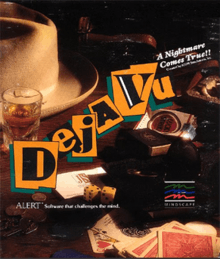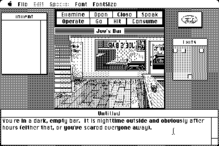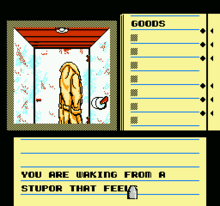Déjà Vu (video game)
Déjà Vu[1] is a point and click adventure game set in the world of 1940s hardboiled detective novels and movies. It was released in 1985 for Macintosh – the first in the MacVenture series – and later ported to several other systems, including the Amiga. Initially, the game featured black and white graphics, and later releases introduced color.
| Déjà Vu | |
|---|---|
 Box art for the computer and NES versions | |
| Developer(s) | ICOM Simulations, Inc. |
| Publisher(s) | Mindscape Kemco (NES, GBC) |
| Composer(s) | Hiroyuki Masuno, Kento's Group (NES) Koji Nishikawa, Masaomi Miura (GBC) |
| Engine | MacVenture |
| Platform(s) | Apple IIGS, Macintosh, Atari ST, Commodore 64, Amiga, MS-DOS, Game Boy Color, PC-9800, Pocket PC, NES, PlayStation 4, Windows 3.x, Xbox One |
| Release | 1985 (Mac) 1987 (MS-DOS) 1988 (Famicom) 1990 (NA NES) 1991 (Windows 3.x) 1992 (PAL NES) 1999 (GBC) 2017 (PlayStation 4, Xbox One) |
| Genre(s) | Adventure |
| Mode(s) | Single-player |
Plot and gameplay

The game takes place in Chicago during December 1941. The game character is Theodore "Ace" Harding, a retired boxer working as a private eye.
The player awakes one morning in a bathroom stall, unable to remember who he is. The bathroom stall turns out to be in Joe's Bar. A dead man is found in an upstairs office, and Ace is about to be framed for the murder. There are some clues as to the identity of the murdered man and to the player himself. A strap-down chair, mysterious vials, and a syringe are found, suggesting (together with a needle mark on the player's arm) that an interrogation has taken place.
Outside the bar, the player encounters adversaries including a mugger, an old acquaintance with a grudge, and the police. The player's boxing background proves to be a valuable asset. The player must find addresses around Joe's bar and then make taxi rides to a few locations (including his office) to gather more elements and unravel the story. It involves a kidnapping in which Ace has played some part, but his memory lacks important details.
Ace's memory and mental condition progressively deteriorate, so the player is required to obtain an antidote to the drug that caused the memory loss. After that, Ace has recurring flashbacks filled with information that help the player to evaluate the evidence and take action accordingly.
This game and its sequel, Deja Vu II: Lost in Las Vegas, require significant lateral thinking. Some situations are based in common detective techniques, while others require simple violence. Unlike other MacVentures titles (such as Uninvited and Shadowgate), no supernatural events are involved.
Technology

Déjà Vu was the first ICOM Simulations to use the MacVenture interface and engine.
Numerous ports were made, including versions for home computer systems in 1987 and the Nintendo Entertainment System in 1990. Versions of the game and its sequel containing new graphics and sound were released for Microsoft Windows in the early 1990s, and later as a combined single-cartridge release for the Game Boy Color in 1999 under the title Déjà Vu I & II: The Casebooks of Ace Harding, which was also released for DOS, Windows 3.x (1992), and Windows Mobile (2002).
Reception
Digital Press gave the NES version 6 out of 10, approving the puzzle-solving while have average opinions on graphics and music.[2]
The game was named the Best Entertainment Product by the Software Publishers Association 1986.[3]
Notes
- Accent marks do not appear on the original game boxes or in-game logo, where the title is written as Deja Vu. However, accent marks appear in the text on the back of the box and in the logos for the NES and Game Boy Color ports. Some sources also add an additional subtitle of "A Nightmare Comes True!!", a tagline that is absent from the in-game logo and NES game box.
- Bueno, Tony (November 1999). "Random Reviews". Digital Press. p. 14.
- Lewis, Peter H (29 April 1986). "Peripherals; Software Gets Its Day in the Sun". The New York Times. Retrieved 31 March 2020.
External links
- Déjà Vu at MobyGames
- Déjà Vu on the Amiga at The Hall of Light (HOL)